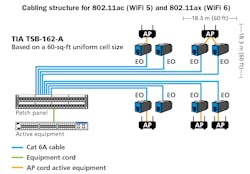Cabling for the next wave of enterprise wireless
By Yuna Shin,
Twenty years ago, first-generation wireless wasn’t considered a necessity. But the technology has evolved to a point where a robust wireless network is mandatory in many building locations, and it’s as crucial to a healthy enterprise as computers and smartphones. Organizations in a variety of sectors have seen a dramatic increase in the network speeds required to operate effectively. These organizations include office environments, manufacturing facilities, schools and campuses, and hospitals.
The enterprise wireless local area network (WLAN) market is now dominated by IEEE 802.11ac (WiFi 5) access points, as 802.11ac made up nearly 87% of enterprise access point shipments by late 2019, according to the IDC Worldwide Quarterly Data Tracker.
IEEE 802.11ac was introduced in 2013, with Wave 2 improvements introduced in 2015. These improvements include multi-user multiple-input/multiple-output (MIMO), which allows a single access point to send data to multiple WiFi devices simultaneously, and an additional 160-MHz channel bandwidth. The Wave 2 improvements also gave WiFi 5 a speed boost, allowing for theoretical speeds of up to 6.9 Gbits/sec, up from 1.3 Gbits/sec with Wave 1.
Even with these improvements to 802.11ac technology, many higher-density environments and high-bandwidth applications have demands that it just can’t meet. For example, sports stadiums, airports, and universities need improved WiFi that can handle huge amounts of traffic. There is also a growing push to untether some high-bandwidth devices that currently require wired Ethernet, such as augmented/virtual reality devices, 4K/8K video, and other videoconferencing applications.
Enter WiFi 6
IEEE 802.3ax (WiFi 6) is poised to meet the emerging demands for higher-density coverage, higher bandwidth, and billions of additional connected Internet of Things (IoT) devices. The 802.11ax standard has been in the works for 7 years, and is expected to be ratified in October 2020. Meanwhile, WiFi 6 routers are already available, with an early wave introduced in 2019 and a second wave of routers and mesh systems arriving this year.
WiFi 6 is not a small, iterative upgrade. The following changes will bring big benefits to businesses and other enterprise applications.
WiFi 6 will be able to increase average client throughput speeds in dense areas by 4 times, with maximum theoretical data rates of 10 Gbits/sec and even higher.
WiFi 6 employs a technology called orthogonal frequency division multiple access (OFDMA), which allows more users with a range of bandwidth requirements to connect to one access point simultaneously. This will alleviate network issues in highly congested areas.
WiFi 6 will support more-efficient power consumption, which is especially important for IoT applications that require more intelligent uses of data and power. WiFi 6 will use a power saving mode called target wake time (TWT), which allows devices to determine when to wake up to send or receive data. This helps save power and reduces congestion.
While WiFi 5 significantly improved wireless performance over WiFi 4 technology, it provides a reduced coverage range because of the shorter wavelength in the 5-GHz frequency band. A shorter wavelength means that the signal has a harder time moving through walls or furniture, so you have to be closer to the access point to get a good signal. WiFi 6 will operate in both the 5-GHz and 2.4-GHz bands simultaneously, improving its reach.
Cable system planning for today and tomorrow
To get the promised performance out of WiFi 5 and future WiFi 6 gear, the Telecommunications Industry Association (TIA) recommends using a minimum of 2 Category 6A cables per wireless access point, which will give you higher data rates and increased power, while simplifying future upgrades.
TIA TSB-162-A recommends using an 18.3-meter uniform cell design, with 2 Category 6A cables to each cell. The length between the patch panel and equipment outlet—the permanent link—should be no more than 80 meters. The channel design in the nearby figure provides the greatest chance to reach the theoretical speeds outlined in standards specifications.How does 5G fit in the enterprise?
Much has been made in the news about the coming 5G cellular upgrades and their impact on wireless networks. There is no doubt that 5G will bring big benefits for certain applications. However, deployments of 5G will be slow, and it will do little to replace enterprise WiFi in the next 10 years.
There are several reasons. First, 5G deployments in the low-band or mid-band will be able to cover indoor locations, but these offerings will not deliver on the big performance promises that come with millimeter wave (mmWave) 5G. As mmWave operates at frequencies that can’t travel through doors, glass, or around corners, any indoor 5G network in mmWave spectrum will probably need a significant number of in-building antennas to cover every corner of every room.
5G deployments also will require significant capital expenditures to install all the 5G electronics, which means 5G won’t get installed unless there can be a return on that investment. In the enterprise, it will be costly to retrofit devices such as laptops, printers, security cameras, and projectors with 5G chipsets.
5G will undoubtedly offer better service for mobile-phone users and mobile applications. At the same time, due to cost, many mobile users will continue to offload from their cellular plans to WiFi when possible.
We will begin to see 5G projects in places like sports stadiums and dense urban areas. At the same time, WiFi also will remain a strong option for locations with a greater density of devices like airports, stadiums, and shopping centers. In fact, public WiFi hotspots will continue to grow dramatically, reaching nearly 549 million globally by 2022, up from 124 million in 2017, according to the Cisco VNI Forecast.
After WiFi 6
While still very early in development, IEEE recently approved a task group to define what will become WiFi 7. The IEEE 802.11be Extremely High Throughput WLAN standard likely will support wireless Ethernet operations in the 1-, 2.4-, 5-, 6-, and 7.25-GHz frequency bands, with a maximum throughput of 30 Gbits/sec.
WiFi 7 is expected to double the spatial streams from 8 to 16, and include MIMO protocol enhancements. The target publication date is at least 4 to 5 years away.
WiFi continues to evolve, and even with major 5G rollouts in the years to come, WiFi will retain a strong presence in enterprise networks for generations to come.
Yuna Shin is senior product manager, copper with Leviton Network Solutions. She manages the company’s Category 6A, 6, and 5e connectivity, and has more than 10 years’ experience in the structured cabling industry. She regularly authors articles and hosts seminars on cabling industry trends.


